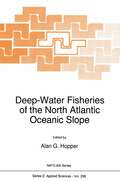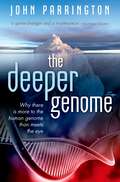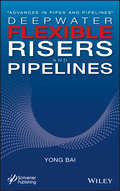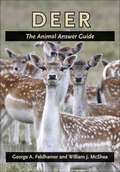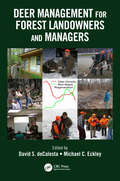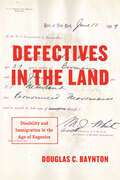- Table View
- List View
Deep Time Analysis: A Coherent View of the History of Life (Springer Geology)
by Mark A.S. McMenaminUsing a series of case studies, the book demonstrates the power of dynamic analysis as applied to the fossil record. The book considers how we think about certain types of paleontological questions and shows how to answer them. The analytical tools presented here will have wide application to other fields of knowledge; as such the book represents a major contribution to the deployment of modern scientific method as it builds on author's previous book, Dynamic Paleontology. Students and seasoned professionals alike will find this book to be of great utility for refining their approach to their ongoing and future research projects.
The Deep Universe: Saas-Fee Advanced Course 23. Lecture Notes 1993. Swiss Society for Astrophysics and Astronomy (Saas-Fee Advanced Course #23)
by A.R. Sandage R.G. Kron M.S. LongairWritten by three celebrated astronomers renowned for their excellence in both research and teaching, the central theme is approached in three complementary ways: the smooth evolution of the universe from the Big Bang to the present structures of matter; as a meandering road paved by our observations of stars, galaxies, and clusters; and how these approaches have been gradually developed and intertwined in the historical process leading to modern-day cosmology.
Deep Water: From the Frilled Shark to the Dumbo Octopus and from the Continental Shelf to the Mariana Trench
by Riley BlackFrom celebrated science writer Riley Black, a beautifully illustrated, compelling deep dive into the life story of the abyss, its ancient creatures, and the scientists and submersibles that have documented them. What lies beneath the surface of the ocean has mystified humankind for millennia. Today, we have explored more of the surface of the Moon than we have the deep sea. What thrives in these mysterious depths, how did these life-forms evolve from ancient life, and how has this environment changed over time as our planet has developed? Introducing us to the ancient, complex, and fascinating life-forms that have evolved into the marine life we recognize today—from stromatolites, structures created by some of the earliest life billions of years ago and still found today, to yeti crabs, bioluminescent firefly squid, and giant jellyfish—Deep Water is an eye-opening journey into the world far beneath the waves. Our guide, brilliant science communicator and self-described “fossil fanatic” Riley Black, has studied marine biology and paleontology, and she brings her vast knowledge and inimitable voice to our voyage. Through text and image, Black leads us further and further into the depths to reveal how this unique and largely unexplored habitat came into being, what lives there and why, how it has evolved, and what the future will bring in this dark and mysterious environment.
Deep-water Coral Reefs: Unique Biodiversity Hot-Spots (Springer Praxis Books)
by Martin HovlandDeep-water coral reefs are found along large sections of the outer continental shelves and slopes of Europe, from North Cape to the Gulf of Cadiz, and because they also occur along the Atlantic seaboard of USA, the Gulf of Mexico, off Brazil, in the Mediterranean, and off New Zealand, they are currently being targeted by international groups of marine scientists. They have become popular and opportune deep-water research targets because they offer exciting frontier exploration, combined with a whole plethora of modern scientific methods, such as deep-sea drilling, sampling, remote control surveying and documentation. Furthermore they represent timely opportunities for further developments within the application of geochemistry, stable isotope research, bacterial sciences, including DNA-sequestering, and medical research (search for bioactive compounds). The Integrated Ocean Drilling Program (IODP) has arranged a deep-sea scientific drilling campaign on giant carbonate banks off Ireland. Because the reefs currently defy traditional marine-ecological theories, they represent future research opportunities and will enjoy scientific scrutiny for many years to come.
Deep-Water Fisheries of the North Atlantic Oceanic Slope (NATO Science Series E: #296)
by Alan G. HopperA comprehensive review of current knowledge of the deep-water fishes of the North Atlantic and their exploitation. Individual countries and research institutions have carried out their own investigations and surveys in the past, but these results have rarely been coordinated, nor has there been a proper sharing of results and data. But there is a need to assess the total size of the deep-water stocks and the extent to which they can safely be exploited. The book also contains a number of papers describing present and past research and the present exploitation of resources, together with papers on the technical problems encountered in capturing and processing these fishes. An assessment of the requirements for future research is presented.
The Deeper Genome: Why there is more to the human genome than meets the eye
by John ParringtonOver a decade ago, as the Human Genome Project completed its mapping of the entire human genome, hopes ran high that we would rapidly be able to use our knowledge of human genes to tackle many inherited diseases, and understand what makes us unique among animals. But things didn't turn out that way. For a start, we turned out to have far fewer genes than originally thought — just over 20,000, the same sort of number as a fruit fly or worm. What's more, the proportion of DNA consisting of genes coding for proteins was a mere 2%. So, was the rest of the genome accumulated 'junk'? Things have changed since those early heady days of the Human Genome Project. But the emerging picture is if anything far more exciting. In this book, John Parrington explains the key features that are coming to light - some, such as the results of the international ENCODE programme, still much debated and controversial in their scope. He gives an outline of the deeper genome, involving layers of regulatory elements controlling and coordinating the switching on and off of genes; the impact of its 3D geometry; the discovery of a variety of new RNAs playing critical roles; the epigenetic changes influenced by the environment and life experiences that can make identical twins different and be passed on to the next generation; and the clues coming out of comparisons with the genomes of Neanderthals as well as that of chimps about the development of our species. We are learning more about ourselves, and about the genetic aspects of many diseases. But in its complexity, flexibility, and ability to respond to environmental cues, the human genome is proving to be far more subtle than we ever imagined.
The Deeper Genome: Why there is more to the human genome than meets the eye
by John ParringtonOver a decade ago, as the Human Genome Project completed its mapping of the entire human genome, hopes ran high that we would rapidly be able to use our knowledge of human genes to tackle many inherited diseases, and understand what makes us unique among animals. But things didn't turn out that way. For a start, we turned out to have far fewer genes than originally thought — just over 20,000, the same sort of number as a fruit fly or worm. What's more, the proportion of DNA consisting of genes coding for proteins was a mere 2%. So, was the rest of the genome accumulated 'junk'? Things have changed since those early heady days of the Human Genome Project. But the emerging picture is if anything far more exciting. In this book, John Parrington explains the key features that are coming to light - some, such as the results of the international ENCODE programme, still much debated and controversial in their scope. He gives an outline of the deeper genome, involving layers of regulatory elements controlling and coordinating the switching on and off of genes; the impact of its 3D geometry; the discovery of a variety of new RNAs playing critical roles; the epigenetic changes influenced by the environment and life experiences that can make identical twins different and be passed on to the next generation; and the clues coming out of comparisons with the genomes of Neanderthals as well as that of chimps about the development of our species. We are learning more about ourselves, and about the genetic aspects of many diseases. But in its complexity, flexibility, and ability to respond to environmental cues, the human genome is proving to be far more subtle than we ever imagined.
The Deeper Genome: Why there is more to the human genome than meets the eye
by John ParringtonOver a decade ago, as the Human Genome Project completed its mapping of the entire human genome, hopes ran high that we would rapidly be able to use our knowledge of human genes to tackle many inherited diseases, and understand what makes us unique among animals. But things didn't turn out that way. For a start, we turned out to have far fewer genes than originally thought - just over 20,000, the same sort of number as a fruit fly or worm. What's more, the proportion of DNA consisting of genes coding for proteins was a mere 2%. So, was the rest of the genome accumulated 'junk'? Things have changed since those early heady days of the Human Genome Project. But the emerging picture is if anything far more exciting. In this book, John Parrington explains the key features that are coming to light - some, such as the results of the international ENCODE programme, still much debated and controversial in their scope. He gives an outline of the deeper genome, involving layers of regulatory elements controlling and coordinating the switching on and off of genes; the impact of its 3D geometry; the discovery of a variety of new RNAs playing critical roles; the epigenetic changes influenced by the environment and life experiences that can make identical twins different and be passed on to the next generation; and the clues coming out of comparisons with the genomes of Neanderthals as well as that of chimps about the development our species. We are learning more about ourselves, and about the genetic aspects of many diseases. But in its complexity, flexibility, and ability to respond to environmental cues, the human genome is proving to be far more subtle than we ever imagined.
The Deeper Genome: Why there is more to the human genome than meets the eye
by John ParringtonOver a decade ago, as the Human Genome Project completed its mapping of the entire human genome, hopes ran high that we would rapidly be able to use our knowledge of human genes to tackle many inherited diseases, and understand what makes us unique among animals. But things didn't turn out that way. For a start, we turned out to have far fewer genes than originally thought - just over 20,000, the same sort of number as a fruit fly or worm. What's more, the proportion of DNA consisting of genes coding for proteins was a mere 2%. So, was the rest of the genome accumulated 'junk'? Things have changed since those early heady days of the Human Genome Project. But the emerging picture is if anything far more exciting. In this book, John Parrington explains the key features that are coming to light - some, such as the results of the international ENCODE programme, still much debated and controversial in their scope. He gives an outline of the deeper genome, involving layers of regulatory elements controlling and coordinating the switching on and off of genes; the impact of its 3D geometry; the discovery of a variety of new RNAs playing critical roles; the epigenetic changes influenced by the environment and life experiences that can make identical twins different and be passed on to the next generation; and the clues coming out of comparisons with the genomes of Neanderthals as well as that of chimps about the development our species. We are learning more about ourselves, and about the genetic aspects of many diseases. But in its complexity, flexibility, and ability to respond to environmental cues, the human genome is proving to be far more subtle than we ever imagined.
Deepwater Flexible Risers and Pipelines
by Yong BaiThe technology, processes, materials, and theories surrounding pipeline construction, application, and troubleshooting are constantly changing, and this new series, Advances in Pipes and Pipelines,, has been created to meet the needs of engineers and scientists to keep them up to date and informed of all of these advances. This second volume in the series focuses on flexible pipelines, risers, and umbilicals, offering the engineer the most thorough coverage of the state-of-the-art available. The authors of this work have written numerous books and papers on these subjects and are some of the most influential authors on flexible pipes in the world, contributing much of the literature on this subject to the industry. This new volume is a presentation of some of the most cutting-edge technological advances in technical publishing. The first volume in this series, published by Wiley-Scrivener, is Flexible Pipes, available at www.wiley.com. Laying the foundation for the series, it is a groundbreaking work, written by some of the world’s foremost authorities on pipes and pipelines. Continuing in this series, the editors have compiled the second volume, equally as groundbreaking, expanding the scope to pipelines, risers, and umbilicals. This is the most comprehensive and in-depth series on pipelines, covering not just the various materials and their aspects that make them different, but every process that goes into their installation, operation, and design. This is the future of pipelines, and it is an important breakthrough. A must-have for the veteran engineer and student alike, this volume is an important new advancement in the energy industry, a strong link in the chain of the world’s energy production.
Deepwater Flexible Risers and Pipelines
by Yong BaiThe technology, processes, materials, and theories surrounding pipeline construction, application, and troubleshooting are constantly changing, and this new series, Advances in Pipes and Pipelines,, has been created to meet the needs of engineers and scientists to keep them up to date and informed of all of these advances. This second volume in the series focuses on flexible pipelines, risers, and umbilicals, offering the engineer the most thorough coverage of the state-of-the-art available. The authors of this work have written numerous books and papers on these subjects and are some of the most influential authors on flexible pipes in the world, contributing much of the literature on this subject to the industry. This new volume is a presentation of some of the most cutting-edge technological advances in technical publishing. The first volume in this series, published by Wiley-Scrivener, is Flexible Pipes, available at www.wiley.com. Laying the foundation for the series, it is a groundbreaking work, written by some of the world’s foremost authorities on pipes and pipelines. Continuing in this series, the editors have compiled the second volume, equally as groundbreaking, expanding the scope to pipelines, risers, and umbilicals. This is the most comprehensive and in-depth series on pipelines, covering not just the various materials and their aspects that make them different, but every process that goes into their installation, operation, and design. This is the future of pipelines, and it is an important breakthrough. A must-have for the veteran engineer and student alike, this volume is an important new advancement in the energy industry, a strong link in the chain of the world’s energy production
Deer: The Animal Answer Guide (The Animal Answer Guides: Q&A for the Curious Naturalist)
by George A. Feldhamer William J. McSheaThink of deer and the image that pops into most American's minds is that of a white-tailed deer, the most common large mammal in North America. Most Europeans are more familiar with red deer. It may surprise many people to know that there are actually about 50 species of deer found throughout the world. Here, readers will find nontechnical, expert information about the wide range of diverse deer species. Did you know that elk and caribou are deer? Or that the earliest fossils of deer are 15 to 20 million years old? Have you ever wondered whether deer swim, play, or see color? How do deer avoid predators and survive the winter? Do deer make good pets or carry contagious diseases? George A. Feldhamer and William J. McShea answer these and other intriguing questions about members of the deer family Cervidae.From the diminutive pudu of South America that weighs 17 pounds to male moose that weigh close to 2,000 pounds, Feldhamer and McShea explore the biology, evolution, ecology, feeding habits, reproduction, and behavior of deer. They chronicle the relationships between humans and deer—both positive and negative—and discuss the challenges of deer conservation and management. With vivid color photographs and an accessible and engaging question-and-answer format, this easy-to-read book is the go-to resource on deer. Nature lovers, hunters, and anyone curious about deer will find this fact-filled book both fascinating and full of surprises.
Deer Management for Forest Landowners and Managers
by David S. deCalesta and Michael C. EckleyThis book is designed to help landowners and forestry professionals develop, implement, and monitor programs to manage both deer and forests with emphasis on resolving deer impact issues. Chapters cover management strategies through identifying and setting goals; managing deer populations and deer impact on land; economics of forest, deer, and impact management; human dimensions of deer management; and developing and implementing integrated management plans. The book presents an integrated, quantitative approach for managing deer populations and impacts so users can manage forest resources sustainably.
Deer Management for Forest Landowners and Managers
by David S. DeCalesta Michael C. EckleyThis book is designed to help landowners and forestry professionals develop, implement, and monitor programs to manage both deer and forests with emphasis on resolving deer impact issues. Chapters cover management strategies through identifying and setting goals; managing deer populations and deer impact on land; economics of forest, deer, and impact management; human dimensions of deer management; and developing and implementing integrated management plans. The book presents an integrated, quantitative approach for managing deer populations and impacts so users can manage forest resources sustainably.
Defect and Material Mechanics: Proceedings of the International Symposium on Defect and Material Mechanics (ISDMM), held in Aussois, France, March 25–29, 2007 (pdf)
by Gérard A. Maugin Claude Stolz C. DascaluDefect Assessment for Integrity Management of Pipelines
by Y. Frank ChengDEFECT ASSESSMENT FOR INTEGRITY MANAGEMENT OF PIPELINES Make energy pipelines safer by improved defect assessment for integrity management Pipelines provide an effective and efficient mode for transportation of energies, including both conventional fossil fuels and renewable energies and fuels such as hydrogen, biofuels and carbon dioxide, over wide ranges and long distances, meeting economic development and civilian needs. While the integrity and safety of in-service pipelines is paramount to pipeline operators, there are many factors which can adversely affect the pipeline integrity and potentially result in pipeline failures and, sometimes, serious consequences. Defect Assessment for Integrity Management of Pipelines provides a thorough and detailed overview of various techniques that can be used to assess corrosion defects, the most common defects on pipelines, and other mechanical defects such as dents, buckles and winkles, all of which constitute essential threats to pipeline integrity. In addition to widely used standards and codes for defect assessment, readers can obtain the latest progress in development of advanced techniques for improved accuracy in defect assessment. From early-stage Level I methods to the newest Level III method integrating with the mechano-electrochemical interaction, Defect Assessment for Integrity Management of Pipelines has everything you need to improve safety of your pipelines. Defect Assessment for Integrity Management of Pipelines readers will also find: Evolution of defect assessment techniques and limitations to be overcome with improved techniques Detailed analysis of defect assessment for determination of fitness-for-service of the pipelines, and prediction of their failure pressures Both theoretical and practical aspects of the defect assessment methods applied on pipelines Defect Assessment for Integrity Management of Pipelines is ideal for pipeline professionals, researchers and graduate students to improve personal knowledge, research expertise, and technical skills.
Defect Assessment for Integrity Management of Pipelines
by Y. Frank ChengDEFECT ASSESSMENT FOR INTEGRITY MANAGEMENT OF PIPELINES Make energy pipelines safer by improved defect assessment for integrity management Pipelines provide an effective and efficient mode for transportation of energies, including both conventional fossil fuels and renewable energies and fuels such as hydrogen, biofuels and carbon dioxide, over wide ranges and long distances, meeting economic development and civilian needs. While the integrity and safety of in-service pipelines is paramount to pipeline operators, there are many factors which can adversely affect the pipeline integrity and potentially result in pipeline failures and, sometimes, serious consequences. Defect Assessment for Integrity Management of Pipelines provides a thorough and detailed overview of various techniques that can be used to assess corrosion defects, the most common defects on pipelines, and other mechanical defects such as dents, buckles and winkles, all of which constitute essential threats to pipeline integrity. In addition to widely used standards and codes for defect assessment, readers can obtain the latest progress in development of advanced techniques for improved accuracy in defect assessment. From early-stage Level I methods to the newest Level III method integrating with the mechano-electrochemical interaction, Defect Assessment for Integrity Management of Pipelines has everything you need to improve safety of your pipelines. Defect Assessment for Integrity Management of Pipelines readers will also find: Evolution of defect assessment techniques and limitations to be overcome with improved techniques Detailed analysis of defect assessment for determination of fitness-for-service of the pipelines, and prediction of their failure pressures Both theoretical and practical aspects of the defect assessment methods applied on pipelines Defect Assessment for Integrity Management of Pipelines is ideal for pipeline professionals, researchers and graduate students to improve personal knowledge, research expertise, and technical skills.
Defect Correction Methods: Theory and Applications (Computing Supplementa #5)
by K. Böhmer H. J. StetterTen years ago, the term "defect correction" was introduced to characterize a class of methods for the improvement of an approximate solution of an operator equation. This class includes many well-known techniques (e.g. Newton's method) but also some novel approaches which have turned out to be quite efficient. Meanwhile a large number of papers and reports, scattered over many journals and institutions, have appeared in this area. Therefore, a working conference on "Error Asymptotics and Defect Corrections" was organized by K. Bohmer, V. Pereyra and H. J. Stetter at the Mathematisches Forschungsinstitut Oberwolfach in July 1983, a meeting which aimed at bringing together a good number of the scientists who are active in this field. Altogether 26 persons attended, whose interests covered a wide spectrum from theoretical analyses to applications where defect corrections may be utilized; a list of the participants may be found in the Appendix. Most of the colleagues who presented formal lectures at the meeting agreed to publish their reports in this volume. It would be presumptuous to call this book a state-of-the-art report in defect corrections. It is rather a collection of snapshots of activities which have been going on in a number of segments on the frontiers of this area. No systematic coverage has been attempted. Some articles focus strongly on the basic concepts of defect correction; but in the majority of the contributions the defect correction ideas appear rather as instruments for the attainment of some specified goal.
Defect Engineering of Carbon Nanostructures (Advances in Material Research and Technology)
by Sumanta Sahoo Santosh Kumar Tiwari Ashok Kumar DasThis book presents an analysis of the techniques used for the synthesis of innovative functional carbon nanostructures. The chapters describe the research and development of various layered carbon nanostructures. Emphasis is given to the impact of defects on carbon nanostructures. The application of carbon nanostructured materials in biomedical field and energy storage is described.
Defect Evolution in Cosmology and Condensed Matter: Quantitative Analysis with the Velocity-Dependent One-Scale Model (SpringerBriefs in Physics)
by C.J.A.P. MartinsThis book sheds new light on topological defects in widely differing systems, using the Velocity-Dependent One-Scale Model to better understand their evolution. Topological defects – cosmic strings, monopoles, domain walls or others - necessarily form at cosmological (and condensed matter) phase transitions. If they are stable and long-lived they will be fossil relics of higher-energy physics. Understanding their behaviour and consequences is a key part of any serious attempt to understand the universe, and this requires modelling their evolution. The velocity-dependent one-scale model is the only fully quantitative model of defect network evolution, and the canonical model in the field. This book provides a review of the model, explaining its physical content and describing its broad range of applicability.
Defect Recognition and Image Processing in Semiconductors 1997: Proceedings of the seventh conference on Defect Recognition and Image Processing, Berlin, September 1997
by J. DonekerDefect Recognition and Image Processing in Semiconductors 1997 provides a valuable overview of current techniques used to assess, monitor, and characterize defects from the atomic scale to inhomogeneities in complete silicon wafers. This volume addresses advances in defect analyzing techniques and instrumentation and their application to substrates, epilayers, and devices. The book discusses the merits and limits of characterization techniques; standardization; correlations between defects and device performance, including degradation and failure analysis; and the adaptation and application of standard characterization techniques to new materials. It also examines the impressive advances made possible by the increase in the number of nanoscale scanning techniques now available. The book investigates defects in layers and devices, and examines the problems that have arisen in characterizing gallium nitride and silicon carbide.
Defect Recognition and Image Processing in Semiconductors 1997: Proceedings of the seventh conference on Defect Recognition and Image Processing, Berlin, September 1997
by J. DonekerDefect Recognition and Image Processing in Semiconductors 1997 provides a valuable overview of current techniques used to assess, monitor, and characterize defects from the atomic scale to inhomogeneities in complete silicon wafers. This volume addresses advances in defect analyzing techniques and instrumentation and their application to substrates, epilayers, and devices. The book discusses the merits and limits of characterization techniques; standardization; correlations between defects and device performance, including degradation and failure analysis; and the adaptation and application of standard characterization techniques to new materials. It also examines the impressive advances made possible by the increase in the number of nanoscale scanning techniques now available. The book investigates defects in layers and devices, and examines the problems that have arisen in characterizing gallium nitride and silicon carbide.
Defect Sizing Using Non-destructive Ultrasonic Testing: Applying Bandwidth-Dependent DAC and DGS Curves
by Wolf KleinertThis book presents a precise approach for defect sizing using ultrasonics. It describes an alternative to the current European and American standards by neglecting their limitations. The approach presented here is not only valid for conventional angle beam probes, but also for phased array angle beam probes. It introduces an improved method which provides a significant productivity gain and calculates curves with high accuracy. Its content is of interest to all those working with distance gain size (DGS) methods or are using distance amplitude correction (DAC) curves.
Defectives in the Land: Disability and Immigration in the Age of Eugenics
by Douglas C. BayntonImmigration history has largely focused on the restriction of immigrants by race and ethnicity, overlooking disability as a crucial factor in the crafting of the image of the “undesirable immigrant.” Defectives in the Land, Douglas C. Baynton’s groundbreaking new look at immigration and disability, aims to change this. In the late nineteenth and early twentieth centuries, Baynton explains, immigration restriction in the United States was primarily intended to keep people with disabilities—known as “defectives”—out of the country. The list of those included is long: the deaf, blind, epileptic, and mobility impaired; people with curved spines, hernias, flat or club feet, missing limbs, and short limbs; those unusually short or tall; people with intellectual or psychiatric disabilities; intersexuals; men of “poor physique” and men diagnosed with “feminism.” Not only were disabled individuals excluded, but particular races and nationalities were also identified as undesirable based on their supposed susceptibility to mental, moral, and physical defects. In this transformative book, Baynton argues that early immigration laws were a cohesive whole—a decades-long effort to find an effective method of excluding people considered to be defective. This effort was one aspect of a national culture that was increasingly fixated on competition and efficiency, anxious about physical appearance and difference, and haunted by a fear of hereditary defect and the degeneration of the American race.
Defectives in the Land: Disability and Immigration in the Age of Eugenics
by Douglas C. BayntonImmigration history has largely focused on the restriction of immigrants by race and ethnicity, overlooking disability as a crucial factor in the crafting of the image of the “undesirable immigrant.” Defectives in the Land, Douglas C. Baynton’s groundbreaking new look at immigration and disability, aims to change this. In the late nineteenth and early twentieth centuries, Baynton explains, immigration restriction in the United States was primarily intended to keep people with disabilities—known as “defectives”—out of the country. The list of those included is long: the deaf, blind, epileptic, and mobility impaired; people with curved spines, hernias, flat or club feet, missing limbs, and short limbs; those unusually short or tall; people with intellectual or psychiatric disabilities; intersexuals; men of “poor physique” and men diagnosed with “feminism.” Not only were disabled individuals excluded, but particular races and nationalities were also identified as undesirable based on their supposed susceptibility to mental, moral, and physical defects. In this transformative book, Baynton argues that early immigration laws were a cohesive whole—a decades-long effort to find an effective method of excluding people considered to be defective. This effort was one aspect of a national culture that was increasingly fixated on competition and efficiency, anxious about physical appearance and difference, and haunted by a fear of hereditary defect and the degeneration of the American race.




